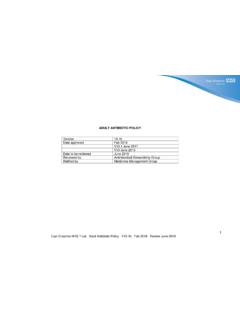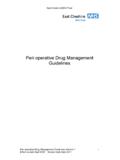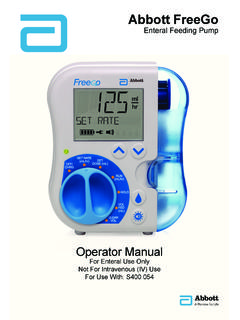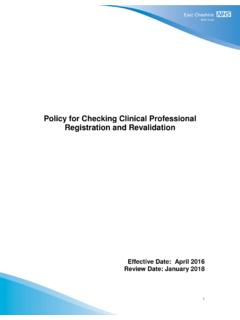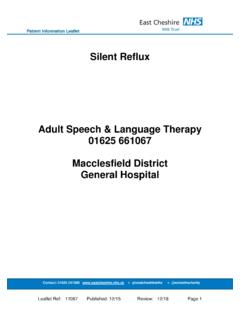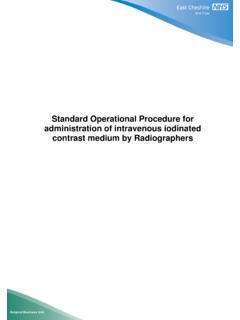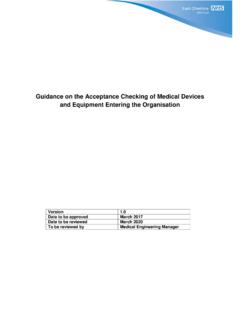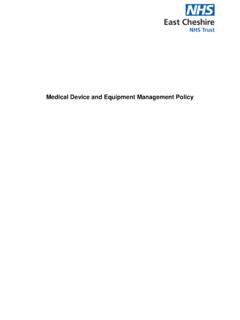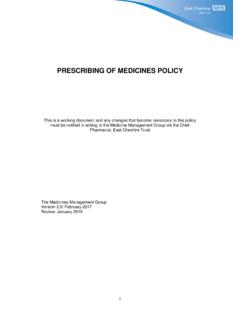Transcription of Guidelines for Prevention and Management of …
1 CNSG East Cheshire NHS Trust Guidelines for Prevention and Management of refeeding syndrome in Adults Page 1 of 11 Guidelines for Prevention and Management of refeeding syndrome in Adults CNSG East Cheshire NHS Trust Guidelines for Prevention and Management of refeeding syndrome in Adults Page 2 of 11 Policy Title: Guidelines for Prevention and Management of refeeding syndrome in Adults Executive Summary: To provide guidance for the Prevention and Management of refeeding syndrome in adult inpatients at East Cheshire NHS Trust (ECT).
2 Supersedes: New Guidelines Description of Amendment(s): New Guidelines This policy will impact on: All clinical staff caring for adult inpatients at East Cheshire NHS Trust. Financial Implications: Effective, timely Prevention and early Management of refeeding syndrome will reduce costs associated with the adverse medical outcomes of unmanaged refeeding syndrome . Policy Area: Trust Wide Document Reference: ECT002366 Version Number: 1 Effective Date: July 2015 Issued By: Kath Senior, Executive Director of Nursing, Performance and Quality Review Date: December 2018 Authors: Amanda Hamilton and Karen Allsopp (Dietitians) Impact Assessment Date: APPROVAL RECORD Committees/Group Date Consultation.
3 Clinical Nutrition Steering Group Departments of Nutrition & Dietetics and Pharmacy Medicines Management Group CNSG East Cheshire NHS Trust Guidelines for Prevention and Management of refeeding syndrome in Adults Page 3 of 11 CONTENTS PAGES INTRODUCTION 4 AIMS 4 ORGANISATIONAL RESPONSIBILITIES Medical Staff Dietitians Matrons and Ward Managers Ward Pharmacists Biochemist 4-5 IDENTIFYING PATIENTS AT RISK Patients at Moderate Risk Patients at High Risk Patients at Extremely High Risk 5-6 Management Management Patients at moderate risk of refeeding syndrome Patients at high risk of refeeding syndrome Electrolyte Supplementation Considerations for route of nutrition support Oral Enteral Parenteral Monitoring REFERENCES Table 1 Appendix 1: Flow diagram for ECT Management of refeeding syndrome Appendix 2.
4 Equality and Human Rights Policy Screening Tool 6-7 CNSG East Cheshire NHS Trust Guidelines for Prevention and Management of refeeding syndrome in Adults Page 4 of 11 INTRODUCTION The term refeeding syndrome encompasses the adverse consequences which can occur in the early stages of providing nutrition to a malnourished individual (if the proper preparation and Management is not employed.) These include: Acute thiamine deficiency resulting in Wernicke s encephalopathy and Korsakoff syndrome , with the potential for permanent cognitive impairment (loss of short term memory.)
5 Hypophosphataemia, hypokalaemia and hypomagnesaemia Fluid overload resulting in cardiac failure. Even in a well nourished individual, there is sufficient tissue reserve of thiamine for only 21 days. In the malnourished patient thiamine levels may be very close to total depletion. During starvation, usage of thiamine is low. Once feeding begins however, the absorption of carbohydrate leads to usage and degradation of thiamine at the entry point to and within the Kreb s cycle. Frank deficiency of thiamine can then occur, leading to the onset of Wernicke-Korsakoff syndrome , or cardiac sequelae.
6 Starvation causes adaptive reductions in cellular activity and organ function, accompanied by electrolyte and micronutrient depletion. Insulin concentrations decrease and glucagon levels rise, resulting in gluconeogenesis and the breakdown of protein and lipid. Free fatty acids and ketone bodies replace glucose as the major energy source. refeeding (oral, enteral or parenteral nutrition) triggers a switch from fat to carbohydrate metabolism, with consequent insulin release, and increased shift of potassium, phosphate and magnesium and water into cells. In the starved individual, cardiac mass may be significantly depleted, leading to the risk of fluid overload and cardiac failure if feed and fluid provision is too rapid or too AIMS The aim is to provide evidence based guidance and establish consensus within the Trust on the consistent identification, Prevention and Management of refeeding syndrome .
7 ORGANISATIONAL RESPONSIBILITIES The Executive Director of Nursing, who is a member of the Trust Board, has overall responsibility for the provision of nutrition within ECT. The Clinical Nutrition Steering Group (CNSG) is responsible for the oversight of all aspects of nutrition within ECT and is accountable to the Quality Strategy Steering Group, which is turn accountable to the Trust Board via the Safety and Quality Standards Committee (SQS). For further information regarding the role and responsibility of the CNSG in the provision of nutrition, refer to the East Cheshire NHS Trust Nutrition Policy for in-patients (CNSG001).
8 All clinical service team managers are responsible for ensuring compliance with this guidance within their unit/team and that staff are competent and attend appropriate training. Certain professional groups and departments have specific responsibilities. Medical Staff are responsible for: CNSG East Cheshire NHS Trust Guidelines for Prevention and Management of refeeding syndrome in Adults Page 5 of 11 Promoting awareness of the risks, Prevention and Management of refeeding syndrome when initiating nutritional support. Prescribing thiamine before starting nutrition support in patients at risk of refeeding syndrome .
9 Ensuring appropriate and timely biochemical monitoring and supplementation of electrolytes. Prescription of a multivitamin- mineral preparation. Dietitians are responsible for: Assessing the referred patient s risk of refeeding syndrome . Assessing the referred patient s nutritional requirements and where appropriate prescribing the appropriate enteral or parenteral feeding regimen. Assisting in promoting awareness of the risks and Management of refeeding syndrome . Matrons and Ward Managers are responsible for ensuring that: All patients are screened for the risk of malnutrition using the Malnutrition Universal Screening Tool (MUST) on admission and weekly thereafter.
10 Nursing staff refer patients identified at risk of malnutrition (MUST score of 2 or more) to the Department of Nutrition and Dietetics. Ward Pharmacists are responsible for: Ensuring that prescribable oral nutritional supplements are correctly prescribed. Advice on thiamine and electrolyte prescription. Biochemists are responsible for: Advice on biochemistry results with appropriate recommendations for Management of electrolytes and micronutrients. CNSG East Cheshire NHS Trust Guidelines for Prevention and Management of refeeding syndrome in Adults Page 6 of 11 IDENTIFYING PATIENTS AT RISK Any patient who has had little or no nutrition for over 5 days is at some risk.

